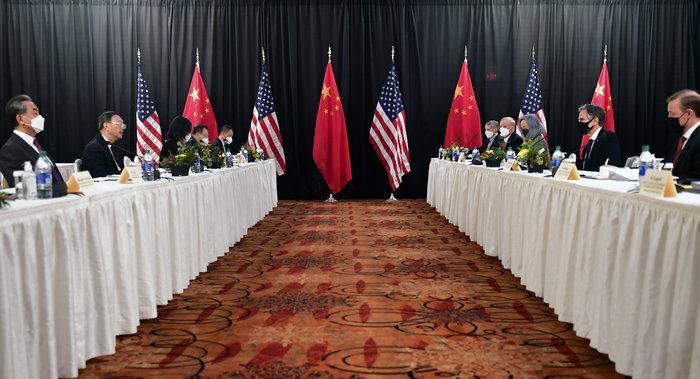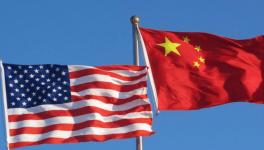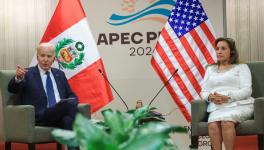Alaska Talks Can be Transformative for US-China Ties

Secretary of State Antony Blinken ( second from right) and national security adviser Jake Sullivan (right) facing Chinese Communist Party foreign affairs chief Yang Jiechi (second from left) and China’s State Councilor Wang Yi, left, at the opening session of US-China talks in Anchorage, Alaska, March 18, 2021
The testiness in the United States’ relations with China surged to the surface last week. The back-and-forth at the US-China talks at Anchorage, Alaska (March 18-19) marked a defining moment. The US readout was skimpy in detail while a more detailed Chinese account has appeared on the website of the State Council of China.
The US and Chinese media both reported an acrimonious exchange at the beginning of the talks with the customary photo-op and initial remarks extending for half an hour, much of it a forceful rebuttal of recent US rhetoric against China by Yang Jiechi, Politburo member and director of the CCP Central Foreign Affairs Commission.
Yang fired back at the US’ recent anti-China rhetoric, bringing into focus the US’ “condescending” approach to the talks; the fallacy of the US’ rhetoric on human rights; Black Lives Matter and deep-seated problems of American racism; the social and economic inequality in America and so on. To quote Yang,
“I don’t think the overwhelming majority of countries in the world would recognise the universal values advocated by the United States, or that the opinions of the United States could represent international public opinion. And those countries would not recognise that the rules made by a small number of people would serve as the basis for the international order.”
No doubt, Yang went prepared to unilaterally expand the scope of the traditional photo-op into a very public verbal jousting in front of TV cameras. The intensity of the hour-long opening exchanges while the cameras whirred has no precedents in US-China relations since the two countries established diplomatic ties in 1978.
What might have been the Chinese intentions? Clearly, Yang was as much conscious of the international audience as of the Chinese public opinion. The optics he transmitted was that any US ingress into China’s sovereignty, core interests and internal affairs will meet with firm unwavering resistance and countermeasures. Second, he flagged the need to accept and adapt rationally to the differences between the two countries.
Third, Yang asserted that China’s comprehensive capability and development potential has reached such a level that the US’ containment strategy is doomed to fail. On the other hand, the acceptance of this reality will enable the two countries to seek cooperation with strategic patience and restraint even in an unfriendly atmosphere. As a Chinese commentary put it, “Those days of being beaten down without striking back are over.”
Nonetheless, the Times report from Anchorage said the talks also “yielded a substantive conversation that lasted far longer than initially planned.” The Chinese communist party daily Global Times in an editorial comment concurs: “After a fierce, tit-for-tat opening, the close-door strategic dialogue afterward between China and the US in Alaska went smoothly and the result was far better than people’s expectations. Both sides completed three rounds of talks. Both admitted in their press conferences that the talks were “candid” and each sought to work with the other side in some fields.”
Indeed, Xinhua reported at the end of the talks that the discussions resulted in the establishment of a Working Group to enhance communication and cooperation on climate change, and that wide-ranging discussions covered a whole range of topics. Yang later described the talks as “direct, frank and constructive.” He said, “This talk helped boost understanding, although the two sides still have big divergences on some issues.”
In a subsequent analysis, however, David Sanger at the Times played down the acrimonious part and put in perspective the current US-China confrontation as a competition over technology, cyberconflict and influence operations that would “bear little resemblance” to a Cold War. Sanger wrote that China’s “pathway to power is building new networks rather than disrupting old ones… Their power arises not from their relatively small nuclear arsenal or their expanding stockpile of conventional weapons. Instead, it arises from their expanding economic might and how they use technology.”
Sanger recalled that Jake Sullivan, Biden’s national security adviser, had also opined in the past that “it could be a mistake to assume that China plans to prevail by directly taking on the United States military in the Pacific.” Sanger quoted Sullivan: “The central premises of this alternative approach (toward China) would be that economic and technological power is fundamentally more important than traditional military power in establishing global leadership, and that a physical sphere of influence in East Asia is not a necessary precondition for sustaining such leadership.”
How long the Biden administration’s charade of “containment” of China will be sustainable remains to be seen. In a recent interview with David Ignatius at the Washington Post, Robert Gates, a rare bipartisan figure in American foreign policy who served as CIA director and Secretary of Defence, put it this way: “If we can’t figure out a way to tackle the big problems facing this country, whether it is infrastructure or immigration or education or a host of others, then I think we are in deep trouble, and that is much more of a danger to the country than any foreign threat, far more than Russia or China. And the question is whether we can get past that.”
Gates added, “I like to say that the biggest threat is confined to the two square miles that encompass the White House and the Capitol building, and if the president can’t figure out a way, and if the congressional leader won’t figure out a way to respond, in terms of working together.., then I think that the divisiveness that we have seen, and the dangerous divisiveness that we have seen probably will only get worse.”
The best outcome of the Anchorage talks would be that the US eschews the Manichean rhetoric and seeks to adapt to a more multipolar global system and an increasingly powerful and important China. Plainly put, China has eroded US power not only in Asia but internationally, both exploiting the anti-globalism of the Trump years to expand its influence in international institutions and by simply creating its own multilateral platforms.
The Regional Comprehensive Economic Partnership (which includes the ASEAN countries plus Australia, New Zealand, South Korea, and Japan) is a telling example. China has outmaneuvered the US in the global economy. Meanwhile, global economy needs an overhaul to address the climate crisis, rampant economic inequality, automation, and other developments, and cooperation with China is essential here for developing new rules.
The narrative that China poses a threat to the “rules-based order”, etc. assumes that there is a singular liberal order and that US interests and the content of the liberal order are identical. In an outstanding essay in 2019 titled China in a World of Orders: Rethinking Compliance and Challenge in Beijing’s International Relations, Alastair Iain Johnston, Professor of China in World Affairs in the Government Department at Harvard, identified at least eight “issue-specific orders” in the international system — and some of these China accepts; some it rejects; and some it is willing to live with. “Given these multiple orders and varying levels of challenge, the narrative of a US-dominated liberal international order being challenged by a revisionist China makes little conceptual or empirical sense,” he wrote.
Fundamentally, the US’ sense of crisis stems from the decline of its comprehensive competitiveness. Herein lies the paradox: The US’ hegemonic framework remains roughly the same but its internal supportive power is weakening. This contradiction cannot be resolved by strengthening ties with all those allies with shrinking economies. Catch-up on the home front becomes a prerequisite.
Get the latest reports & analysis with people's perspective on Protests, movements & deep analytical videos, discussions of the current affairs in your Telegram app. Subscribe to NewsClick's Telegram channel & get Real-Time updates on stories, as they get published on our website.
























